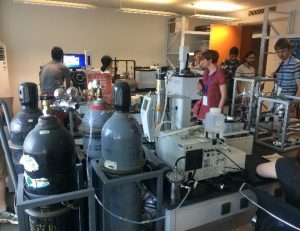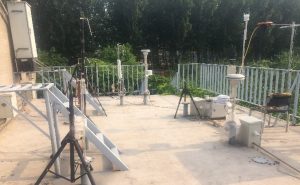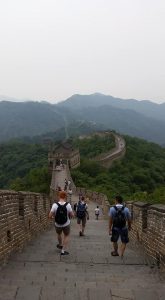My NCAS Trip to Beijing
By Laura Kiely on Wednesday, August 9th, 2017
In June I was lucky enough to join a trip to Beijing organised by the National Centre for Atmospheric Science (NCAS), to attend the Air Pollution and Human Health (APHH) meeting which was taking place there. I’m sure it will come as no surprise to anybody that the sightseeing, the food and the evenings out (Chinese karaoke anyone?) were amazing, but since I’m not being employed by a travel company I’m going to write about the visits organised by NCAS.
The main part of the trip was the APHH meeting, where researchers from the UK and China presented their work on Chinese air quality. This took place over two days and the talks ranged from chemistry to social impacts. The overall message seemed to be that air quality in Beijing is poor, and if we thought the haze outside was bad, data showed it was far worse during winter!
Whilst in Beijing we also visited urban and rural measurement sites which were part of the research campaign, and had a tour of Tsinghua University, where the meeting was held. The urban site is in central Beijing and the rural one is in Pinggu, about 50 miles from Beijing. At the urban site, several shipping containers, each belonging to a UK university, contain the majority of the equipment. Inside these containers, equipment and monitors are stacked against the walls, and tubes fixed to holes in the walls supply air for sampling. Chemical species being monitored included Ozone, Black Carbon and NOx. These containers are designed to be shippable laboratories, which can be taken around the world to study air quality. Unfortunately for the researchers working in them, this does not leave a lot of room for movement and metal containers are not the most comfortable working environment in a hot country. As a result of this, inside each container were multiple air conditioner units and fans, as the scientists tried to protect their computers from the 30°C+ temperatures.
The most impressive feature of the urban site has to be the 325m tall mast with platforms at intervals to allow for vertical profile measurements of chemical species and meteorological measurements. This mast is actually the tallest structure in Beijing and can be seen throughout the city (when the air is clear enough!)
The rural site on the other hand was much smaller. It was based at a farm and consisted of a few buildings surrounded by an orchard. It contained some of the same equipment as the urban site (meteorological and air sampling monitors), located on the roof of one of the buildings. At the rural site research was also done on the health impacts of air quality, and we were also shown the medical rooms where they take volunteers’ blood pressure, heart rate etc.
The trip was not all work, however. The rural site visit was combined with a trip to the Great Wall. Here we were given the option of walking to the top or getting a chair lift, and the group split in two. I was one of the crazy people who thought that walking up a few (thousand) steps would be fun – a decision regretted about a tenth of the way up! This path did, however, give us a nice walk along the wall to meet up with the others and get the toboggan down. Unfortunately, not one atmospheric student had thought to check the weather that morning and just as we were standing in the queue for said toboggan, down came the rain and health and safety put an end to that plan. Resignedly, we all got the chair lift down to arrive at the bottom just as the clouds cleared and the sunshine returned.
(Credit to Tom Thorpe for photos)







